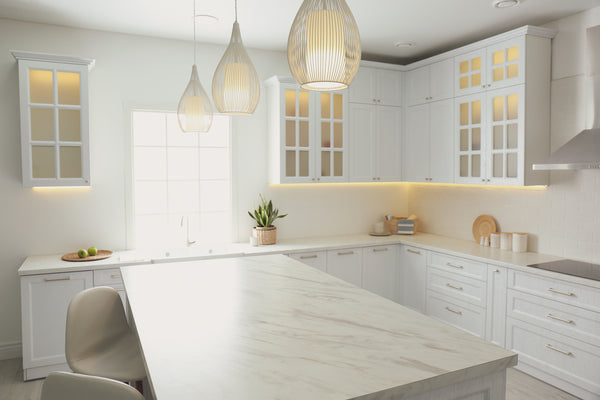
Natural stone countertops are hygienic and durable. But they are still made of porous material. So, if you do not apply an impregnator sealer correctly, they might fill with liquids and oils, to the point that the stains on the surface will not go away without sanding the surface, thus ruining its aesthetic value.
Here is how to properly apply a stone sealer to your countertop. But before we dive in, let’s consider how the type of natural stone may lead you to choose different products for achieving the best results.
Stone Absorbency
Different types of stones have varying absorbency rates. In other words, not every stone is as highly porous as pumice. Granite and travertine, for example, have tight surface tension, which means they do not let much liquid go in by design.
As you may know, even granite countertops get stains from time to time. And depending on the types of granite stains, a stain remover will do. Here is how to effectively remove granite stains before applying an impregnator sealer.
Of course, stone absorbency also influences how soon you need to reapply a sealer. The fastest way to know if your stone countertop needs an impregnating sealer is to make a quick stone absorbency test:
- Pour some water drops on the stone surface to form the tiniest puddle.
- Set a timer and get back after 10 minutes.
- Wipe the water from the countertop and look for dark spots where the water touched the stone.
If you see a color change, let the water evaporate in the next hours and apply a sealer.
About Impregnating Sealers
It is always better to search for more information about the product contents to see if they match your countertop material.
Silane, silicone, and siloxane are three resins used in several impregnator sealers. But they may not work well for every surface. So, it is always good to look for suitable products for your countertops.
This stain-proof sealer, for instance, works well for granite, marble, limestone, and travertine because it contains silanes and fluoropolymer. This means that the coating is effective against freeze-thaw and salt damage.
You could also use it on polished limestone, terracotta, and even smooth poured concrete. On the other hand, siloxane is best for concrete countertops because it is less volatile. So, it reduces dusting.
Silicone works great with agglomerate materials. Think of it as the all-purpose resin. In the majority of impregnator sealer formulas, it works in conjunction with the other two.
How To Apply An Impregnator Sealer To Countertops
1 – Getting Prepared
If the countertop stone has a polished surface, use a lamb’s wool applicator or cloth. But if you have a highly porous stone countertop, you might need a sprayer. In any case, choose the right product for your stone countertop and read the instructions carefully.
Cleaning preparations might be necessary. Of course, you had better remove any object, dust, and debris from the surface you want to cure. Otherwise, evenly applying the impregnator sealer will prove to be hard, if not impossible.
Before you pour the impregnating sealer, make sure the surface is dry. Also, make sure the temperature is not too low as temperature might interfere with the chemical properties of the sealant. A room temperature between 50-86F is best.
2 – Applying the Impregnator Sealer
A little bit of impregnator sealer goes a long way. Plus, you can use a paintbrush or a roller to make sure to cover every angle and detail. As mentioned before, try to work in the product evenly across the entire surface.
When it comes to impregnating sealers, the idea is to give the product enough time to soak into the stone. And depending on the type of stone, you may have to apply more than one coat. Setting a timer to check the sealer did not dry or form a pool is recommendable.
Generally speaking, you need to do two coats. The time between each coating application may vary, but you usually have to wait at least 15 minutes. And after the final coat, you need to use a terry cloth towel or a paper towel and wipe the product down for the last time.
3 – Letting the Sealer Cure
Let the impregnator sealer cure for 24 hours before resuming use of the countertop. But before you leave the room, make sure no residue remains on the stone surface. Otherwise, use more paper towels.
Lastly, use an organic solvent to clean any equipment.